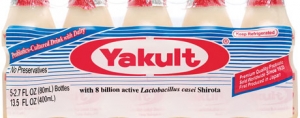Ron Bailey11.01.03
Japan 2003 Yearend Update
Examining what’s been happening in Japan over the last year on the nutraceuticals front.
By Ron Bailey
Although it is not yet certain, it appears that the Japanese economy is finally showing signs of real recovery, after many years of recession and near-depression conditions. Full recovery is expected to require further improvement in the U.S. economy, given the strong trading relationships between the two countries. Signals are positive from Japan, however, including the promise of real government reforms in several important areas.
Demographics Update
The Statistics Bureau in the Ministry of Public Management, Home Affairs, Posts and Telecommunications publishes an annual Statistical Handbook of Japan in English, which is an excellent source of published data extracted from reports from the various governmental agencies in Japan.
In its 2003 issue, the Bureau reported that of the total Japanese population of 127 million in 2002, over 18% were 65 years of age or older, a new record. The population is expected to remain flat through 2010, after which there is expected to be a gradual decline. By the year 2050, the population will be only about 100 million, and the percentage of the population over 65 years of age will be over 35%. These data assume that the current low birth rate and low immigration rates will continue, and clearly highlight the nature of the healthcare challenge for the future.
At the same time, the data on life expectancy continue to show that Japan has the highest life expectancy in the world for both males and females. Life expectancy at birth in 2001 was just over 78 years for males and just under 85 years for females, both all-time highs. The national healthcare system, which covers all Japanese citizens, is typically given some of the credit for the increases in life expectancy. With the exception of certain types of cancer, lung cancer amongst women in particular, the trends in mortality rates from other major diseases (cerebrovascular disease, heart disease and pneumonia, for example) are all down from their peak rates.
Regulatory Update
There have not been any major changes in the functional foods and nutraceutical regulations from the Ministry of Health, Labor and Welfare during this calendar year. The FOSHU (Foods for Specified Health Uses) regulations remain intact, as do the regulations for the newer category of Foods with Nutrient Function Claims. While some of the requirements for these two distinct regulatory categories are being challenged by trade organizations as being too restrictive, it is clear that the credibility of both has been enhanced by the relatively conservative position taken by the Ministry in developing the regulatory framework. There have been no major controversies with products in either category. Further, these categories have not been impacted by the food safety crises impacting other parts of the food industry (i.e., “mad cow” disease, adulterated weight loss products, microbiological contamination, etc.).
It was agreed upon by the Japanese government starting the middle of last year that several food additives in wide distribution in overseas markets but not yet permitted in Japan would be allowed in foods in Japan without going through the formal (and formidable) application process. Food additives widely used in the U.S. dietary supplement industry, such as magnesium stearate as a tableting aid, for example, are now formally allowed. The full list of permitted additives and additional food additives that have been proposed for approval are available (in Japanese at least) from organizations in Japan, such as the Japan Food Industry Center in Tokyo.
FOSHU Category Update
The number of approved FOSHU products continued to grow over the last year and is now (as of early October) up to 398, up from only 309 one year ago. Each of the FOSHU products was approved on a product-by-product basis, as required by the FOSHU regulations, with the final “stamp of approval” and acceptance of specific on-label health claims by the Ministry of Health, Labor and Welfare.
The non-governmental organization responsible for the administration of the FOSHU application process, the Japan Health Food and Nutrition Food Association (JHNFA), reported retail sales of all FOSHU products in 2002 at just under $4 billion at the current exchange rate. It is anticipated that the next formal JHNFA sales report expected by early next year will show continued growth for the category, even though no large sales volume foods have converted from non-FOSHU to FOSHU status so far during 2003.
Looking at just those 64 new FOSHU products that have been granted approval so far this calendar year, the following observations can be made:
Functional Ingredients. Over one-third (23 of 64) of the approved products used the popular indigestible dextrin as the “functional ingredient,” using claims related to gastrointestinal health and/or blood sugar control. New ingredients used for the first time in approved FOSHU products in 2003 included polyglutamic acid for calcium absorption, phospho-oligosaccharide calcium (“Pos-Ca”), which “remineralizes teeth,” bunaharitake (a tree fungus) extract for “people beginning to be concerned about hypertension and touichi extract for people beginning to be concerned about blood sugar levels.
Health Claim Categories. It is interesting to note that the six primary FOSHU health claims categories accounted for all of the new product introductions in 2003, although with some changes in the wording of the claims. Gastrointestinal health, blood sugar control, dental health, calcium absorption, blood cholesterol and lipid control and blood pressure control were the health claim targets. A few of the FOSHU products were allowed to make more than one health-related claim. It is no coincidence that most of these same health-related conditions are an important part of the annual nutrition survey of the Japanese population commissioned by the Ministry of Health, Labor and Welfare.
Product Forms. Nearly 40% (25 of 64) of the FOSHU products approved this year were considered “soft drinks” (including seven powdered soft drinks), which is consistent with the historical FOSHU experience. Other popular product forms included ten “sardine processed foods” with sardine peptide as the functional ingredient, seven chewing gums, seven kale or barley processed foods and four tablet candies. Other approvals included cooking oil, mayonnaise, soup, soymilk, yogurt, etc.—typical of previous years.
There had been some concern that the modified FOSHU regulations enacted last year might have a negative impact on the number of FOSHU approvals, given the potential for increased costs of FOSHU product development because of new clinical study guidelines. That does not appear to have happened, however, perhaps because reputable Japanese companies regularly provide a nearly equivalent level of safety and efficacy scientific support for their non-FOSHU food and food ingredient introductions. For overseas companies without a Japanese presence, however, the requirement for at least one Japanese subject clinical efficacy study and the submission of extensive FOSHU application supporting documents in Japanese represents a significant financial commitment.
Non-FOSHU Functional Foods
It is important to recognize that at the same time that the FOSHU market is growing, the introduction of new non-FOSHU functional foods is continuing in Japan as well. A scan of the “Functional Foods, Health Foods and Supplements” section of recent issues of the Japanscan Food Industry Bulletin published monthly in the U.K. provides some perspective on the products and ingredients of interest. Milk and yogurts with probiotics and prebiotics and lactoferrin, malted white and brown rice, chocolate and green tea polyphenols, fortified beverages and soymilks, slimming and sports drink products with amino acids, “balanced nutritional foods” with vitamins and minerals and conjugated linoleic acid (CLA) and soy isoflavones are just some of the examples featured.
Expectations for the Future
The outlook for continued growth in the functional foods and nutraceuticals categories in Japan is very positive, for all of the reasons mentioned. The recent challenge from outside Japan for the Japanese to demonstrate that the introduction of FOSHU products is having a measurable positive impact on the health of the Japanese population is beginning to be addressed. A positive correlation would be difficult for foreign regulatory bureaucrats to ignore as they attempt to develop new functional food and nutraceutical regulatory strategies for their respective countries.NW
















